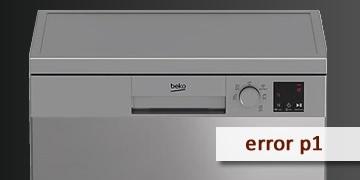Beko Dishwasher Error p1
Index of contents
What is the P1 Beko error affecting your dishwasher?
Having a Beko dishwasher means you have a high-quality appliance. However, these devices are not exempt from experiencing damage and presenting failures in their components, especially if they haven't received the proper maintenance.
This would be the case with the P1 error code on Beko dishwashers. An error which indicates that there's a problem with the water supply and the dishwasher is completely dry. Remember that water is the primary tool for your dishwasher to perform its job in the most optimal way, so please do not deprive it of that.
If the machine displays the P1 error and it flashes on the dishwasher's screen, it means it's not receiving enough water or that the water isn't reaching it with adequate pressure. To get to the bottom of this issue and solve this problem once and for all, you will need to check various parts of your dishwasher's system.
This failure can have several causes that trigger this P1 error code, and we're going to name each one of them:
- The water tap is closed or has low pressure: This prevents the dishwasher from receiving the necessary flow of water.
- The water inlet filter is dirty or obstructed: This reduces the water flow into the dishwasher and can cause dirt to accumulate inside.
- The water inlet hose is bent, crushed, or damaged: This hampers the flow of water to the dishwasher and can cause leaks or breaks.
- The water inlet valve is defective or broken: This means the dishwasher can't properly control the water tank filling, which can lead to too much or too little water.
- The water level sensor is dirty or damaged: This causes the dishwasher to misread the amount of water in the tank, potentially leading to an error in the washing cycle.
How to fix the P1 error of the Beko dishwasher?
Fortunately, this type of failure is easily repairable. So, we bring you a series of tips and advice that you can apply to fix the P1 error code affecting your dishwasher by yourself:
- Reset the dishwasher: First and foremost, let's start with the easiest and simplest step. Completely turn off the dishwasher and unplug it from the electrical outlet for a few minutes. If you don't have easy access to the dishwasher's wiring, you can switch off the circuit breaker that controls the electric supply to your kitchen, but don't worry, it'll only be for a few minutes. After waiting, reconnect your dishwasher and turn it on to see if the error has disappeared. Sometimes, this might be enough to solve the issue and clear the error code because the sensors get reset and recalibrated.
- Check the water tap: Ensure that this tap is fully open and has adequate pressure. If necessary, adjust the valve or open the tap more to increase the water flow. The water supply should be smooth and constant for your dishwasher to operate normally. Remember that water is the “fuel” for your dishwasher, so you should never deprive it of that.
- Clean the water inlet filter: Disconnect the water inlet hose from the tap and from the dishwasher. Remove the filter at the end of the hose and clean it with a soft-bristle brush under running water and a little bit of vinegar. If you notice that it's very dirty or damaged, you'll need to replace it with a new one.
- Check the water inlet hose: Ensure that it's not bent, crushed, or damaged. If it is, straighten it or replace it with a new one. Also, check for any leaks or drips in the hose and repair them if necessary.
- Inspect the water inlet valve: Remove the dishwasher's lower panel and locate the valve connected to the water inlet hose. Check if it's dirty, clogged, or damaged. If so, clean it with a soft-bristle brush and a bit of vinegar or replace it with a new one.
- Clean the water level sensor: Locate the sensor at the bottom of the dishwasher's water tank. Clean it with an electronic cleaner to remove any dirt or soap residue that might interfere with its operation.
- Repeat all the above steps if the problem persists: It wouldn't hurt to double-check. Ensure you've followed all the steps thoroughly and didn't leave anything to chance in these situations. Go over everything again and make sure everything is in order.
- Contact Beko's technical support to address the issue: If you can't resolve the issue on your own, it's best to reach out to Beko's technical service. They have the necessary tools to accurately diagnose the problem and provide a prompt and efficient solution.
In summary, the P1 error code in Beko dishwashers tells you that the problem is related to water. There's a water supply failure, and you need to check several things to solve this issue:
- Reset the dishwasher
- Check the water tap
- Clean the water inlet filter
- Inspect the water inlet hose
- Verify the water inlet valve
- Clean the water level sensor
- Repeat all the above steps if the problem persists
- Contact Beko's technical support to address the issue
